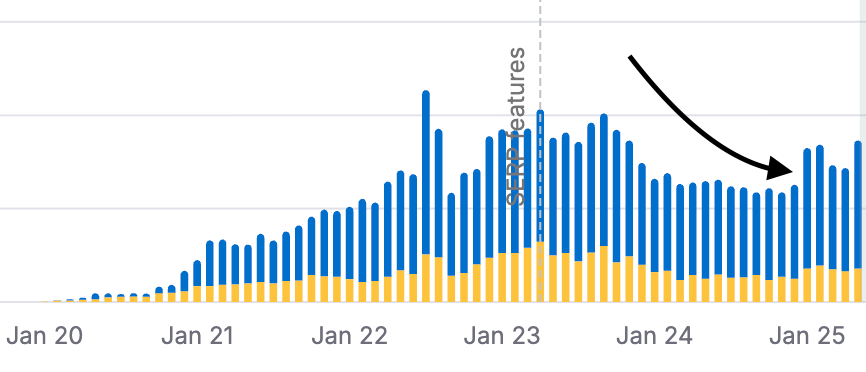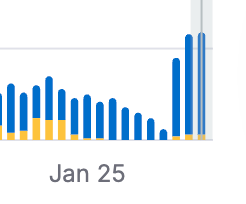Key Takeaways
- Focus on What Converts: SEO success in SaaS isn’t about traffic growth. It’s about driving demos, signups, and pipeline.
- Simplify the Foundation: Logical URLs and clean keyword grouping often outperform heavy-handed technical fixes.
- Refresh What You Already Have: Updating existing content including product pages and top-of-funnel blogs can unlock faster wins than new content creation.
- Link It All Together: Internal linking bridges the gap is underrated and allows you to inform search engines about what keywords a page should rank for.
- Think Like Your ICP: Every new content piece should solve a real pain point and connect to your product narrative.
- AI Isn’t Replacing SEO: The fundamentals still matter. AI visibility will depend on the same relevance, authority, and trust signals.
If you’ve been following the conversation around SEO lately, you know it’s getting much harder to distinguish fact from noise.
The fast expansion of AI search makes so many B2B leaders feel like the ground is shifting under their feet, while an endless number of unhelpful “SEO hacks” flood LinkedIn daily.
For most B2B SaaS marketing leaders, that leaves more questions than answers:
-
- How do we account for AI?
- Has SEO changed completely?
- Is all this technical optimization still worth it?
- Is there a framework we can follow to improve our search visibility?
The truth is, the perceived complexity of AI and SEO have made us discard the fundamentals (hint: they still work!). What has changed is how we prioritize them and incorporate them into a holistic SEO plan.
At Directive, as the industry-leading B2B SEO agency, we’ve seen too many SaaS teams waste months chasing perfect technical scores or publishing hundreds of unoptimized blogs in a desparate attempt to grow visibility. My goal for this guide is to give you a roadmap of the most important fundamentals of B2B SaaS SEO (that actually work) to help you make meaningful strides in improving your SEO visibility, without pulling your hair out.
This roadmap will help you stabilize your existing SEO presence, uncover low hanging fruit opportunities in your current site, and build a plan that can create measurable and meaningful pipeline growth.
Step 1. Start With the Right Foundation (But Don’t Overcomplicate It)
Let me be clear: a strong SEO foundation still matters, but it’s often misunderstood.
Too many SaaS SEO strategies start with 60-page technical audits that never get implemented (many of which have now become even more complicated to seem accommodating for AI search). The reality is, the biggest ranking lifts often come from fixing the simplest issues.
Here’s where I’d recommend to focus immediately:
- Logical URL Structure: Use subfolders to group related topics, such as /solutions or /use-cases. Google better understands and rewards this hierarchy, despite what you may hear.
- Keyword Inclusion: Include primary keywords directly in your URLs. If you are targeting the keyword “b2b seo agency” with your page, you should be sure it’s URL slug is close to “/b2b-seo-agency”. It’s old-school, simple advice that still works, and we’ve measured consistent ranking gains from it. Below is an example of almost immediate growth in Page 1 keywords for a client after product page URLs were changed to better align with target keywords.

- Broken Links and Poor User Experience: Reviewing across the site for broken links is one of the best ways to clean up your technical health and make an immediate difference in your rankings (while also reducing potential issues with user experience).
- Performance Hygiene: Keep your site fast and your structure intuitive (easy to navigate with clear user pathways), but don’t chase perfection. Using your competitors as clear benchmarks in https://pagespeed.web.dev/ will get you to a good spot!
While many guides emphasize SEO fundamentals, most never clarify how to prioritize them. That’s where most SaaS marketers get stuck – knowing what matters but not what to tackle first.
A B2B SaaS SEO agency like Directive can help build a customized roadmap tailored to your goals and resources. But even without outside help, starting small with these foundational improvements (logical URLs, keyword-aligned structure, and crawl accessibility) is a consistent, proven way to strengthen both your organic and AI search visibility.
Step 2. Optimize What Already Exists (Your Fastest Wins)
Before investing in new content, start by improving the content that already has traction. Most SaaS sites have dozens of underperforming assets hiding major potential, including their main core Product/Solutions pages.
Upgrade Product and Solutions Pages
These pages are your conversion workhorses – and they’re often the most neglected. They are the best match to rank for valuable bottom-of-funnel (BOFU) terms like CRM software for SaaS startups or B2B data enrichment tools. Thus, improving these pages is one of the fastest ways to grow your pipeline quickly.
To unlock that potential:
- Expand copy to address key use cases and decision criteria.
- Add keyword depth using 3rd party tools without losing readability.
- Add FAQ sections that include target keywords and answer common user questions.
- Incorporate proof points like client logos, testimonials, or short success metrics.
- Prioritize keyword use in H2 and H3 headers
- Link to these pages using target keywords to tell search engines what keywords the page should rank for.
A well-optimized solutions page can outperform months of new content production.
Refresh and Reoptimize Existing TOFU Content
Your existing blogs and guides likely have untapped SEO potential. Older posts often suffer from outdated information, missing schema, and thin keyword coverage.
Refresh them by:
-
- Updating stats, key information, and examples.
- Rewriting intros and CTAs for modern search intent.
- Adding internal links to updated BOFU content.
- Expanding keyword density naturally using 3rd party tools to capture secondary queries.
- Updating the date posted/modified on the page to show freshness of content, a major factor for search engines and AI models
We’ve seen extremely fast improvements in page 1 keyword visibility for TOFU content immediately after refreshing:

Step 3. Strengthen Internal Linking
Internal linking is the bridge that connects all your optimization efforts. It helps search engines understand what keywords the linked page should rank for and funnels authority from top-performing content to high-value pages.
Follow this general structure:
- Top-of-funnel → Mid-funnel → Bottom-of-funnel: Link educational content to their corresponding product and proof pages.
- Cross-link by cluster: Connect use-case and product page content to each other.
- Add contextual links: Use keyword-rich anchor text that mirrors real queries.
Again, although internal linking is commonly mentioned by top B2B SEO agencies, it’s importance is commonly underemphasized, often because of how simple it can be!
Step 4. Create Valuable Content That Solves ICP Problems (Not Just Adds Keywords)
Most SaaS blogs focus on volume – publish fast, publish often. But the brands that win in 2025 are the ones that create intentionally for their ICP’s specific pain points.
Start by asking:
- What are our ideal buyers searching when they first encounter their problem?
- What blockers or objections slow down their evaluation?
- Where does our product naturally fit into that journey?
This approach moves content from vanity impressions to measurable influence on MQLs, SQLs, and revenue.
How to Apply This
- Map ICP challenges to funnel stages and build content for each stage: Problem → Solution → Product → Proof.
- Build content around questions your audience actually asks in calls, demos, or communities.
- Create “pathway content” that educates and subtly introduces your solution as part of the fix.
- Include real examples, screenshots, or expert commentary (leverage subject matter expert interviews where needed to fill knowledge gaps).
When your content connects customer pain to your solution, it doesn’t just stop at ranking, it drives meaningful pipeline.
Step 5. The Ongoing B2B SaaS SEO Roadmap
Once your foundation and content are optimized, the real work begins: maintaining and multiplying that initial momentum. To be clear, an ongoing B2B SaaS SEO strategy isn’t a static checklist, but it is a consistent, continuing process that combines optimization, expansion, and authority-building into your day-to-day marketing operations.
Here’s what that looks like in practice:
Continual Optimization
SEO isn’t “set it and forget it.” Every quarter, review what content is working and what isn’t. Update metadata, refresh underperforming content, expand internal links, etc. This cadence ensures your pages stay competitive even as search algorithms and user behaviors evolve.
Authority and Brand Building
In the current landscape with AI search, authority is more than backlinks – it’s brand visibility. Google’s algorithms (and now AI-powered search models like ChatGPT) prioritize brands that are mentioned often, while showing consistency, expertise, and trust across multiple channels.
That’s where digital PR plays a crucial role:
- Earn Mentions Across the Web: Secure placements on reputable SaaS review sites, partner blogs, or industry roundups.
- Leverage Owned Data and Research: Create proprietary reports of your first-party data or original studies that other publishers cite.
- Collaborate With Influencers and SMEs: Co-create webinars, podcasts, or LinkedIn posts that drive external mentions and referral traffic.
In practical terms:
- The more your brand appears on credible third-party sources, the more likely AI models and search engines are to surface your content in their responses.
- Digital PR placements act as validation layers, signaling that your company is relevant, trusted, and worth surfacing for relevant prompts.
- For example, when someone searches “what is the best B2B SEO agency” in ChatGPT, your site being listed on three external sources and mentioned in Business Insider could help you secure the number one spot in results.
Expanding Topical Coverage
After your core content clusters are established, broaden your topical authority by adding new pages for emerging features, applications, integrations, or industries. This step ensures your brand continues to capture new search demand as your product and its applications evolve.
Alignment With Demand Generation
SEO works best when it aligns with broader marketing initiatives. Integrate your organic content releases with product launches, paid media campaigns, events, and more to maximize visibility.
Think of SEO as the long-term compounding layer underneath your go-to-market efforts.
Once you have these processes in place, your team can move into a predictable rhythm that balances optimization with innovation. This, of course, will vary depending on the organization, but can serve as a rough outline for your first year of SEO/content marketing work:
| Timeframe | Focus Areas | Key Deliverables |
| 0–90 Days | Technical fixes, core content optimization | Crawl cleanup, URL structure improvements, refresh top content |
| 90–180 Days | Authority building, internal linking | Structured data, cluster interlinking, content refreshes |
| 180–365 Days | Expansion and PR | New ICP-focused content, digital PR placements, programmatic updates |
Where Does AI Fit Into This SEO Roadmap?
AI is changing how people discover, evaluate, and choose SaaS products. While this topic deserves a full guide of its own (check out the Directive blog for related insights), here are the essentials to focus on today:
- Stick to SEO Fundamentals: AI models still surface the same trustworthy, authoritative content that ranks well in search. Good SEO practices continue to pay off.
- Track AI Visibility: Use tools like Scrunch or Profound to monitor where your site appears within AI-generated responses for target prompts. If you see you aren’t appearing for certain prompts, create new content or optimize existing content that could appear for that specific prompt.
- Create Listicle-Style BOFU Content: “Best X for Y” or “Top Tools for Z” content tends to perform better within AI-generated results. Directive’s own site has seen incredible growth in AI visibility by creating this type of content and including Directive’s name.
- Humanize Your Content: AI can surface factual info, but thought leadership, perspective, and real-world proof keep you differentiated for readers.
For a deeper breakdown, watch our video covering 4 ways to rank better in AI Overviews and AI platforms, where we dive into examples and new approaches in detail.
B2B SaaS SEO Case Study: Inscribe
To provide a brief example of the power of strong SEO for B2B SaaS, check out one of our B2B SEO case studies with Inscribe. Inscribe is a fraud detection and automation platform that uses AI to return fraud insights in seconds.
The challenge – Inscribe had a relatively small site that showed potential but hadn’t been refined. After a Series A, they wanted to grow organic quickly and direct effort toward quick, high-impact wins.
Knowing this focus on low-hanging fruit, Directive shifted early effort from heavy website auditing to content research and frontloaded briefs to accelerate publication (aiming to obtain the quick wins mentioned above). The approach focused on a full-funnel demand generation plan anchored to core topics like fraud detection and document collection, while carefully targeting bottom-funnel intent within those SERPs. The team also managed keyword research, content briefs, and coordination with Inscribe’s internal writer and developers to move fast on core pages.
The results:
- 32% increase in organic traffic quarter over quarter
- 237% increase in organic keyword rankings quarter over quarter
- 50% increase in Domain Authority, including a 16-point DA lift in Q2 while a primary competitor gained 1 point in the same period
This is the power of aligning quick execution with proven fundamental B2B SaaS SEO strategies..
When to Bring in a B2B SaaS SEO Agency like Directive
B2B SaaS SEO is evolving (as it always has), but it’s not disappearing. The fundamentals, of course, still matter, and the winners in SEO and AI search will be the organizations who execute efficiently and focus on what’s been proven to work.
If your SEO has plateaued or your team is spread too thin to maintain a consistent roadmap, it may be time to bring in an expert to make life easier for you and your team.
Directive’s team of B2B SaaS SEO consultants help SaaS brands connect technical optimization, content strategy, and digital PR into one unified growth engine.
We help you:
- Simplify your foundation for faster wins
- Optimize existing pages and refresh outdated content
- Develop ICP-led content that drives real pipeline
- Integrate AI and digital PR into your SEO strategy
- Most importantly, drive the results you’ve always wanted from search
To learn more, check out our SEO service page, visit our content marketing service page, and connect with our team for more personalized information.
-
 Ben Glass-Liu
Ben Glass-Liu
Did you enjoy this article?
Share it with someone!
